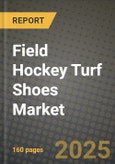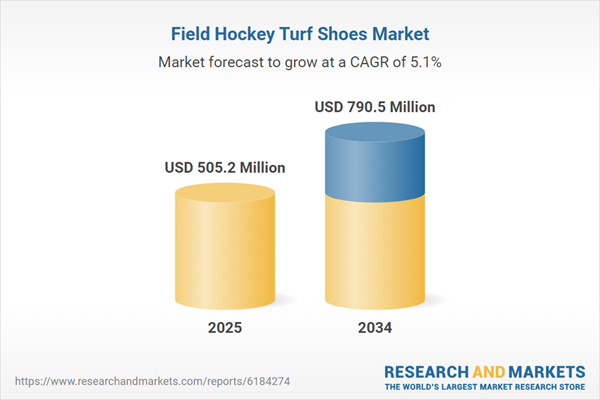Field Hockey Turf Shoes Market
Field hockey turf shoes are purpose-built footwear engineered for synthetic pitches - water-based, sand-dressed, and sand-filled - balancing traction, agility, and protection. Designs pair multi-nub rubber outsoles and hybrid stud patterns with low stack heights for stable, quick directional changes; reinforced toe-drag zones withstand abrasive motions during tackles and drag-flicks; and midfoot shanks, external heel counters, and lateral outriggers curb inversion on wet surfaces. Uppers favor lightweight mesh or engineered textiles with PU hot-melts for durability, while EVA/TPU midsoles tune rebound and ground feel. Moisture management, antimicrobial linings, and dewatering channels address all-weather play, and women’s-specific lasts and junior sizing broaden the addressable base.Demand is anchored in school and club ecosystems, national leagues, and tournament cycles, with growth supported by women’s participation, broadcast visibility, and year-round indoor/outdoor programs. Brands compete across three tiers: value (school pack-ins), performance (league play), and elite (pro-level traction compounds, carbon plates, BOA/quick-lace systems). Channel dynamics favor specialty teamwear dealers and e-commerce, with team contracts and bulk kitting influencing share. Product roadmaps emphasize multi-surface versatility (turf + dry natural), sustainability (recycled uppers, bio-based rubbers), and injury-risk mitigation via proprioceptive platforms and tuned torsion. Key challenges include price pressure from generic turf trainers, counterfeit risks online, seasonality of demand, and variability in pitch types which complicates universal outsole design. Still, technical differentiation - especially traction-on-wet, toe-drag durability, and women’s fit - continues to justify premium ASPs and defend category relevance against broader football/soccer turf alternatives.
Field Hockey Turf Shoes Market Key Insights
- Traction on wet is the battleground. High-sipe, micro-lug patterns and sticky rubber compounds deliver grip on water-based pitches without turf “bite” that slows pivots; channel geometry sheds film to prevent hydroplaning.
- Toe-drag durability drives replacements. Abrasion-resistant rands and TPU films around the forefoot materially extend life for elites; modular toe guards and patch kits open after-sales revenue while cutting returns.
- Fit segmentation expands the pie. Women’s-specific lasts, junior flex patterns, and wide-fit variants reduce injury risk and boost conversion; removable insoles and orthotic-friendly beds improve comfort across long match days.
- Stability without bulk. Low-profile midsoles with medial/lateral outriggers, midfoot plates, and decoupled heels control roll on slick turf, preserving agility; excessive cushioning is avoided to maintain ground feel.
- Versatility matters to clubs. Multi-surface outsoles (turf + hard ground) and indoor-capable gum options simplify kit lists for schools and travel teams, raising volume per SKU.
- Sustainability becomes a spec. Recycled knit uppers, water-borne adhesives, and bio-based rubber blends appear in mid/high tiers; credible claims and durability parity are prerequisites for team adoption.
- Digital and DTC tilt share. Size-fit finders, 3D try-on, and seasonal drops boost e-commerce sell-through; team portals with bundle pricing (shoe + shin + glove) lock in programs early.
- Injury-mitigation features sell. Heel geometry, Achilles relief, and torsion tuning marketed alongside ankle-stability narratives resonate with parents, coaches, and athletic trainers.
- Counterfeit and gray market risks. Unique outsole signatures, serialized tags, and authorized-dealer maps protect brand equity; team contracts and league approvals steer buyers to official channels.
- Pricing ladders harden. Clear step-ups - compound quality, rand coverage, plate tech, and warranty - justify premiums; value tiers lean on colorways and school packs to maintain velocity.
Field Hockey Turf Shoes Market Reginal Analysis
North America
Growth is led by women’s scholastic and collegiate programs, club travel circuits, and expanding youth participation. Buyers prioritize reliable grip on wet astro, toe-drag durability, and women’s-specific fit. Teamwear distributors and e-commerce dominate, with pre-season kitting and in-season replenishment windows shaping demand. Compliance with school purchasing portals, easy returns, and warranty clarity are decisive. Indoor season creates opportunities for dual-surface SKUs.Europe
A mature hockey ecosystem across the Netherlands, Germany, Belgium, the UK, and Spain sustains high technical expectations. Water-based and sand-dressed pitches demand wet-traction compounds and refined torsion control. Clubs favor multi-tier offerings for academy-to-elite pathways, while federation approvals and team deals influence spec. Sustainability credentials and repairability (toe-cap patches) gain weight in procurement.Asia-Pacific
Australia and New Zealand emphasize elite performance and durability; Japan and Korea value precision fit and low-noise outsoles; India, Malaysia, and parts of Southeast Asia add volume via school and academy builds. Hot-humid climates stress upper breathability and antimicrobial treatments. Localized sizing, competitive mid-tier pricing, and robust toe-drag protection are critical to win school tenders and club kits.Middle East & Africa
South Africa anchors participation with school and club leagues, prioritizing grip on mixed turf conditions and rugged outsole compounds for hotter surfaces. Gulf programs and expat leagues are growing from a smaller base, valuing heat-resistant materials and easy online access. Import reliance makes after-sales support, spare laces/insoles, and quick size swaps important for retention.South & Central America
Argentina leads with strong women’s programs and rising youth academies; Chile and Uruguay contribute regional momentum. Consumers seek pro-inspired traction and durable toe protection at accessible price points. Distribution is a mix of specialty retailers and team dealers, with currency swings favoring locally warehoused inventory. Seasonal peaks align with tournament calendars, rewarding brands that plan colorway refreshes and rapid replenishment.Field Hockey Turf Shoes Market Segmentation
By Application
- Professional
- Amateur
By Distribution Channel
- e-Commerce Websites
- Independent Sports Outlet
- Franchised Sports Outlet
By Material
- K-Leather
- Natural Leather
- Synthetic Leather
- Others
By End-User
- Men
- Women
- Children
Key Market players
Adidas, Asics, Nike, New Balance, Grays, Kookaburra, Osaka Hockey, TK Hockey, Dita, STX, Opro (apparel/footwear accessories), Mizuno, Puma, Hummel, Under ArmourField Hockey Turf Shoes Market Analytics
The report employs rigorous tools, including Porter’s Five Forces, value chain mapping, and scenario-based modelling, to assess supply-demand dynamics. Cross-sector influences from parent, derived, and substitute markets are evaluated to identify risks and opportunities. Trade and pricing analytics provide an up-to-date view of international flows, including leading exporters, importers, and regional price trends.Macroeconomic indicators, policy frameworks such as carbon pricing and energy security strategies, and evolving consumer behaviour are considered in forecasting scenarios. Recent deal flows, partnerships, and technology innovations are incorporated to assess their impact on future market performance.
Field Hockey Turf Shoes Market Competitive Intelligence
The competitive landscape is mapped through proprietary frameworks, profiling leading companies with details on business models, product portfolios, financial performance, and strategic initiatives. Key developments such as mergers & acquisitions, technology collaborations, investment inflows, and regional expansions are analyzed for their competitive impact. The report also identifies emerging players and innovative startups contributing to market disruption.Regional insights highlight the most promising investment destinations, regulatory landscapes, and evolving partnerships across energy and industrial corridors.
Countries Covered
- North America - Field Hockey Turf Shoes market data and outlook to 2034
- United States
- Canada
- Mexico
- Europe - Field Hockey Turf Shoes market data and outlook to 2034
- Germany
- United Kingdom
- France
- Italy
- Spain
- BeNeLux
- Russia
- Sweden
- Asia-Pacific - Field Hockey Turf Shoes market data and outlook to 2034
- China
- Japan
- India
- South Korea
- Australia
- Indonesia
- Malaysia
- Vietnam
- Middle East and Africa - Field Hockey Turf Shoes market data and outlook to 2034
- Saudi Arabia
- South Africa
- Iran
- UAE
- Egypt
- South and Central America - Field Hockey Turf Shoes market data and outlook to 2034
- Brazil
- Argentina
- Chile
- Peru
Research Methodology
This study combines primary inputs from industry experts across the Field Hockey Turf Shoes value chain with secondary data from associations, government publications, trade databases, and company disclosures. Proprietary modeling techniques, including data triangulation, statistical correlation, and scenario planning, are applied to deliver reliable market sizing and forecasting.Key Questions Addressed
- What is the current and forecast market size of the Field Hockey Turf Shoes industry at global, regional, and country levels?
- Which types, applications, and technologies present the highest growth potential?
- How are supply chains adapting to geopolitical and economic shocks?
- What role do policy frameworks, trade flows, and sustainability targets play in shaping demand?
- Who are the leading players, and how are their strategies evolving in the face of global uncertainty?
- Which regional “hotspots” and customer segments will outpace the market, and what go-to-market and partnership models best support entry and expansion?
- Where are the most investable opportunities - across technology roadmaps, sustainability-linked innovation, and M&A - and what is the best segment to invest over the next 3-5 years?
Your Key Takeaways from the Field Hockey Turf Shoes Market Report
- Global Field Hockey Turf Shoes market size and growth projections (CAGR), 2024-2034
- Impact of Russia-Ukraine, Israel-Palestine, and Hamas conflicts on Field Hockey Turf Shoes trade, costs, and supply chains
- Field Hockey Turf Shoes market size, share, and outlook across 5 regions and 27 countries, 2023-2034
- Field Hockey Turf Shoes market size, CAGR, and market share of key products, applications, and end-user verticals, 2023-2034
- Short- and long-term Field Hockey Turf Shoes market trends, drivers, restraints, and opportunities
- Porter’s Five Forces analysis, technological developments, and Field Hockey Turf Shoes supply chain analysis
- Field Hockey Turf Shoes trade analysis, Field Hockey Turf Shoes market price analysis, and Field Hockey Turf Shoes supply/demand dynamics
- Profiles of 5 leading companies - overview, key strategies, financials, and products
- Latest Field Hockey Turf Shoes market news and developments
Additional Support
With the purchase of this report, you will receive:- An updated PDF report and an MS Excel data workbook containing all market tables and figures for easy analysis.
- 7-day post-sale analyst support for clarifications and in-scope supplementary data, ensuring the deliverable aligns precisely with your requirements.
- Complimentary report update to incorporate the latest available data and the impact of recent market developments.
This product will be delivered within 1-3 business days.
Table of Contents
Companies Mentioned
- Adidas
- Asics
- Nike
- New Balance
- Grays
- Kookaburra
- Osaka Hockey
- TK Hockey
- Dita
- STX
- Opro (apparel/footwear accessories)
- Mizuno
- Puma
- Hummel
- Under Armour
Table Information
| Report Attribute | Details |
|---|---|
| No. of Pages | 160 |
| Published | November 2025 |
| Forecast Period | 2025 - 2034 |
| Estimated Market Value ( USD | $ 505.2 Million |
| Forecasted Market Value ( USD | $ 790.5 Million |
| Compound Annual Growth Rate | 5.1% |
| Regions Covered | Global |
| No. of Companies Mentioned | 15 |









